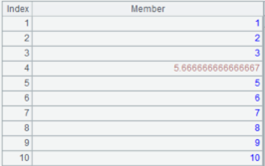impute()
Here are how to use impute() functions.
A.impute()
Description:
Impute missing values to a sequence type variable during modeling.
Syntax:
|
A.impute() |
During modeling, impute missing values to variable A and return a binary sequence containing the imputation result and imputation process records Rec |
|
A.impute@r(Rec) |
During scoring, impute missing values to variable A according to imputation process records Rec |
Note:
The external library function (See External Library Guide) imputes missing values to a sequence type variable during modeling.
Parameter:
|
A |
A sequence |
|
Rec |
A sequence of imputation process records |
Option:
|
@c |
Modify the original data to the imputation result after execution |
|
@BNIED |
Each option specifies a target type, and options are mutual-exclusive; automatically judge the type when no option is used; the order of priorities of the options is binary, numeric, integer and date |
Return value:
Sequence
Example:
|
|
A |
|
|
1 |
[1,2,3,,5,6,7,8,9,10] |
|
|
2 |
=A1.impute@N() |
Impute missing data to A1: A3(1) Return imputation result; A3(2) Imputation process records Rec. @N specifies the type of variable as numeric. |
|
3 |
=A1.impute@rc(A2(2)) |
Impute missing data to A1 according to A2’s imputation process records Rec.
|
P.impute()
Description:
The external library function (See External Library Guide) imputes missing values to a table sequence/record sequence type variable during modeling.
Syntax:
|
P.impute(cn) |
During modeling, impute missing values to variable cn and return a binary sequence containing the imputation result and imputation process records Rec |
|
P.impute@r(cn, Rec) |
During scoring, impute missing values to variable cn according to imputation process records Rec |
Parameter:
|
P |
A table sequence/record sequence |
|
cn |
A string/number, which is the name of column (or the column number starting from 1) – the to-be-pre-processed variable – in a table sequence or record sequence |
|
Rec |
A sequence of imputation process records |
Option:
|
@c |
Modify the original data to the imputation result after execution |
|
@BNIED |
Each option specifies a target type, and options are mutual-exclusive; automatically judge the type when no option is used; the order of priorities of the options is binary, numeric, integer and date |
Return value:
A sequence
Example:
|
|
A |
|
|
1 |
=T("D: //house_prices_train.csv") |
|
|
2 |
=A1.impute@I(4) |
Impute missing values to the variable of column 4: A2(1) Imputation result; A2(2) Imputation process records. @I specifies the type of variable as integer. |
|
3 |
=A1.impute@rc("LotFrontage",A2(2)) |
Impute missing data to A1’s variable according to A2’s imputation process records and return imputation result. @c enables changing the original data to the imputation result after execution. |


